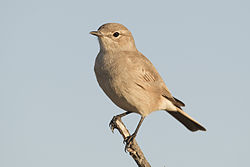| Agricola | |
|---|---|
 | |
| Chat flycatcher (Agricola infuscatus) | |
| Scientific classification | |
| Kingdom: | Animalia |
| Phylum: | Chordata |
| Class: | Aves |
| Order: | Passeriformes |
| Family: | Muscicapidae |
| Genus: | Agricola Bonaparte, 1854 |
| Type species | |
| Saxicola infuscata Smith, A, 1839 | |
Agricola is a genus of small passerine birds in the large family Muscicapidae commonly known as the Old World flycatchers. They are restricted to sub-Saharan Africa.